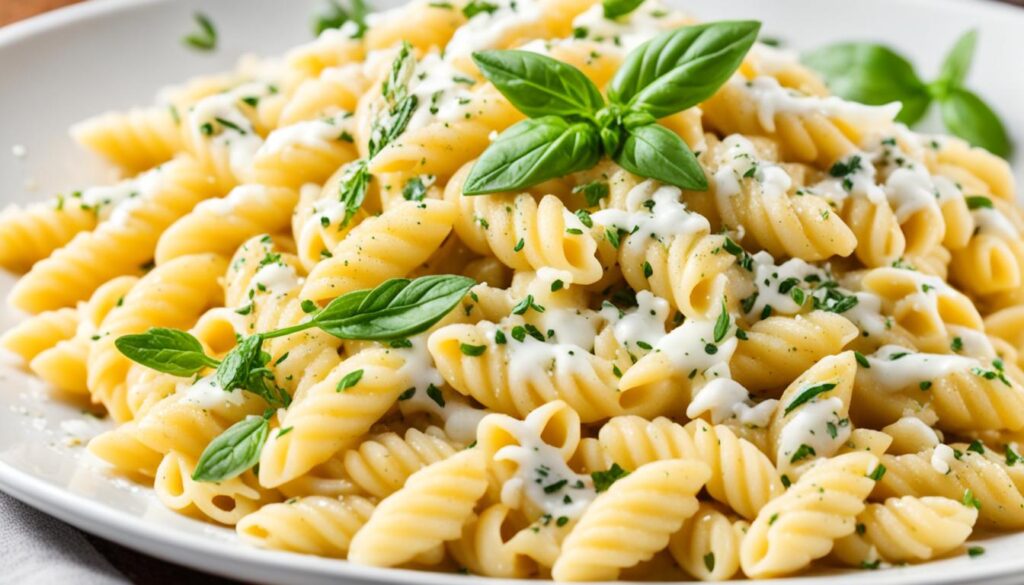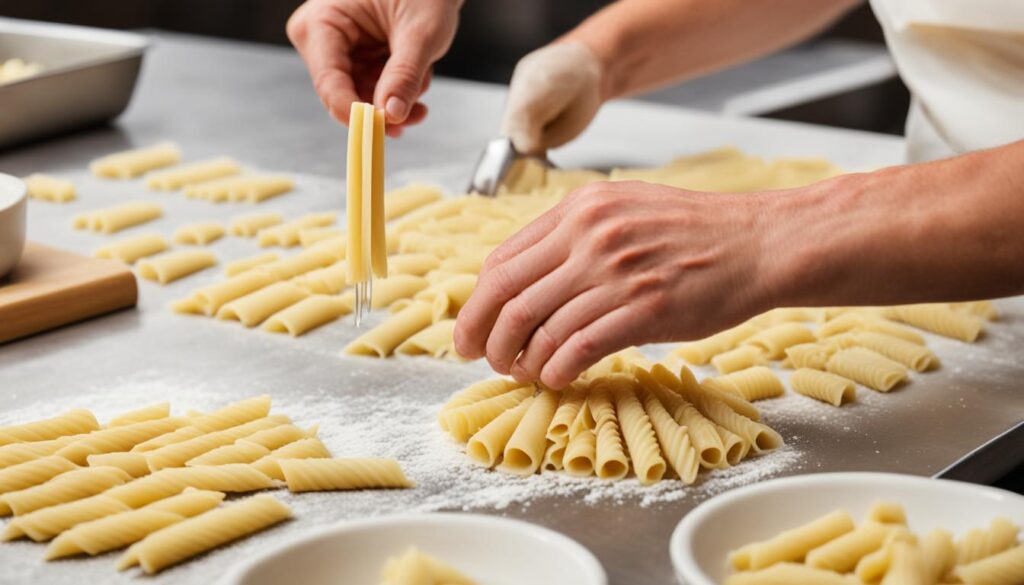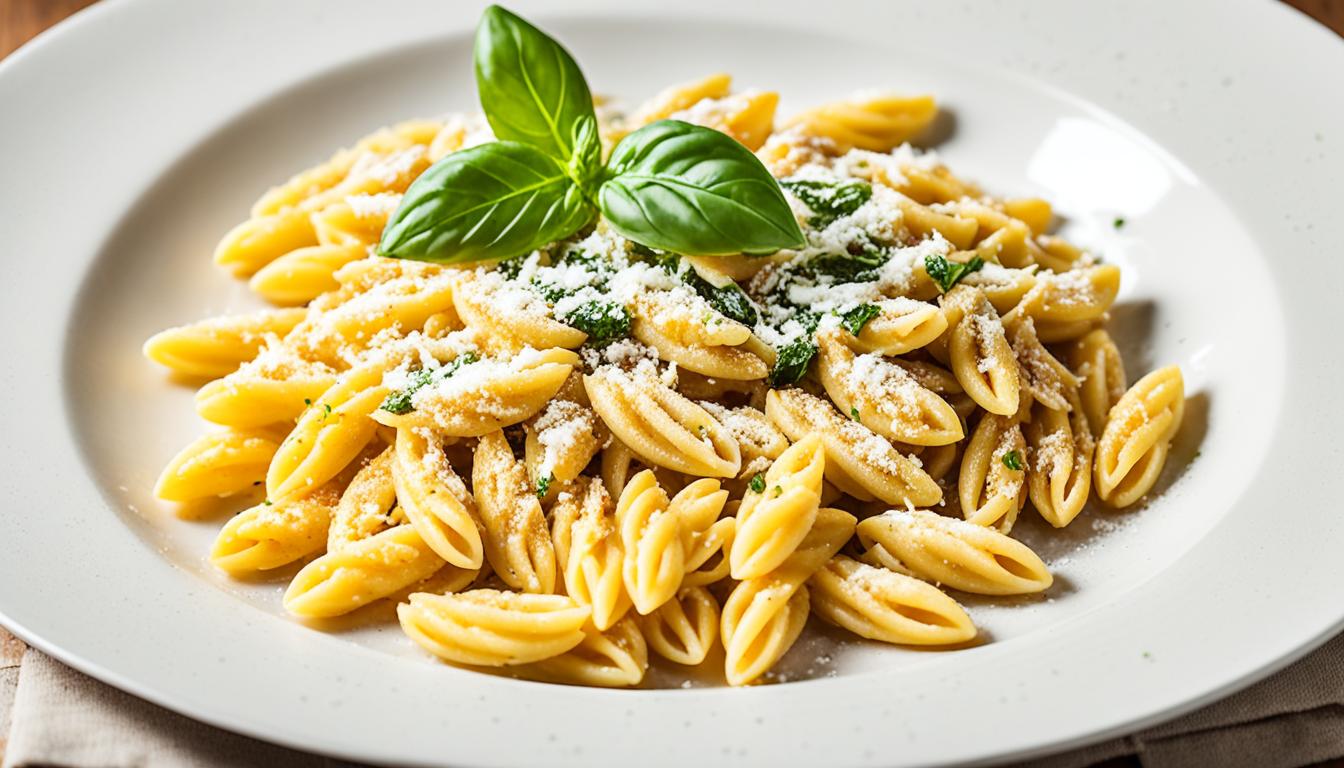Ever wondered why cavatelli pasta is known for its comfort? This Italian pasta, shaped like small shells, is special among traditional pasta types. We’ll explore its history, how to make it, and its place in Italian cuisine. Cavatelli’s versatility makes it great with many sauces, offering more than just tradition. For more info, check out this detailed guide on cavatelli pasta.
Key Takeaways
- Cavatelli is a unique and popular form of Italian pasta.
- It is characterized by its small shell-like shape, perfect for holding sauces.
- This pasta originated in southern Italy and has deep historical significance.
- Making cavatelli at home requires only basic ingredients like flour and water.
- Cavatelli pairs well with a variety of sauces, enhancing any dish.
- Variations such as “scialatielli” and “cazzarelli” highlight its regional adaptability.
Cavatelli Overview
Cavatelli pasta is a unique type of Italian pasta. It has a special shape that looks like small shells or mini hot dog buns. This shape makes it visually appealing and great for holding sauces. It’s made with semolina flour and water, making it part of Italy’s rich pasta traditions.
This pasta is small in size, making it versatile for many dishes. Chefs and home cooks love its chewy texture. It works well with a variety of ingredients and tastes. You can find it in everything from hearty meat sauces to light vegetable dishes and even salads.
Knowing how cavatelli works in cooking opens up many possibilities for tasty meals. It comes in both dried and fresh forms. This gives cooks lots of options for their recipes.
What Kind of Pasta Is a Cavatelli?
Cavatelli pasta is a special kind of traditional pasta. It has a unique shell-like shape. This shape makes it great at holding onto sauces, which is why people love it.
It’s made with semolina flour and water. This gives it a firm texture. This texture is perfect for both creamy and chunky sauces.
Definition and Characteristics
This pasta is called shell pasta because of its hollow shape. It’s made by rolling small pieces of dough into tubes and curling the edges in. This creates its special look.
When you try different pasta types, you’ll see that cavatelli is fun to eat. It has a nice bite and a strong feel in your mouth. This makes eating more enjoyable.
Popular Uses in Cuisine
Cavatelli is known for being versatile in Italian cuisine. It goes well with many sauces, like tomato, creamy, and even soups and stews. It’s great in many dishes.
- Cavatelli with broccoli and cream
- Cavatelli with clams
- Cavatelli in rich tomato sauce with sausage
- Cavatelli tossed with seasonal vegetables and olive oil
It’s used in both home cooking and fancy restaurants. This shows how important cavatelli is in cooking traditions. Its ability to fit into many recipes makes it a favorite among pasta fans.

The History of Cavatelli
Cavatelli comes from Southern Italy, especially Puglia. It started in the 16th century, a time when making pasta was done by hand. This shows the deep Italian pasta history. The name “cavatelli” means “to hollow out” in Italian, fitting its unique shape for sauces.
Origins in Southern Italy
Old stories tell us cavatelli was a simple dish made in homes. Women would come together to make it, creating a strong food culture. This tradition made the regional Italian cuisine richer, keeping family recipes alive for years.
Evolution Over the Centuries
Over time, cavatelli changed in recipe and how it was made. It became popular in different regions, leading to many Italian pasta varieties. For example, “scialatielli” from Campania shows how the pasta has evolved. Cavatelli has always been important in Italian food, celebrated in festivals and traditions. It’s like tortellini, another beloved pasta with its own special place in Italian food and various fillings.
Cavatelli Pasta Making
Making cavatelli pasta is easy and lets home cooks connect with traditional pasta. This small pasta shape is loved for its unique texture and versatility. It’s important to know the basic ingredients and steps to make cavatelli well.
Basic Ingredients
The main things you need for cavatelli are:
- Semolina flour
- Water
- (Optional) Salt
- (Optional) All-purpose flour for texture
These simple ingredients highlight the traditional pasta’s rustic roots. While the classic semolina and water mix is common, adding other ingredients can make the pasta taste and feel better.
Step-by-Step Preparation
Making cavatelli pasta is a hands-on task that’s both fun and rewarding. Here’s how to do it:
- In a mixing bowl, combine semolina flour and water to form a cohesive dough.
- Knead the dough until it becomes smooth and elastic.
- Roll the dough into thin ropes about the width of a pencil.
- Cut the ropes into small pieces, roughly about an inch long.
- Using a gnocchi board or fingers, shape each piece into its characteristic form, creating grooves to hold sauces.
When you make cavatelli, you bring traditional pasta to life. It connects you with Italy’s rich culinary heritage.

| Step | Description |
|---|---|
| 1 | Combine semolina flour and water. |
| 2 | Knead the dough until smooth. |
| 3 | Roll into thin ropes and cut into small pieces. |
| 4 | Shape with gnocchi board or by hand. |
Pasta Shapes: Understanding Cavatelli
Cavatelli is a standout among Italian pasta for its unique shape and feel. It’s called strascinata or dragged pasta, thanks to its special making process. It’s smaller than big pasta like rigatoni but bigger than delicate ones. This makes it great for many sauces and ingredients.
The shape of cavatelli looks like small shells or dumplings. This shape helps it hold onto sauces well. It’s ideal for rich, hearty meals needing a pasta with substance. Cavatelli’s special traits add to the joy of exploring authentic Italian dishes.
| Characteristic | Cavatelli | Other Pasta Types |
|---|---|---|
| Shape | Small, shell-like | Varies from long strands to small shapes |
| Texture | Firm and chewy | Varies; can be smooth or rough |
| Common Uses | Hearty sauces, baked dishes | Soup, salads, light sauces |
| Cooking Time | About 10-12 minutes | Depends on the type |
Learning about cavatelli’s unique traits helps improve the cooking and eating experience of Italian food. It shows how cavatelli can mix with different ingredients for tasty meals.
Cavatelli in Italian Cuisine
Cavatelli is a beloved dish in traditional Italian cuisine. It comes in many forms and is made in different ways across Italy. Each type has its own taste and uses local ingredients, showing off the area’s food traditions.
Regional Variations
There are many cavatelli types, each showing its own twist. In Campania, “scialatielli” is a wide version, often with seafood sauces. In Molise, “cazzarelli” has a special texture and way of making, showing off local cooking skills. These examples show how cavatelli is a key part of regional Italian food.
Signature Dishes Featuring Cavatelli
Cavatelli combines well with local tastes in dishes. In the south, it’s often with broccoli rabe for a strong, earthy taste. Near the coast, it’s paired with seafood for a fresh mix of flavors. It also stars in dishes like lamb ragu or creamy pumpkin sauce, proving its versatility in traditional and modern meals across Italy.
| Region | Cavatelli Variation | Signature Dish | Main Ingredients |
|---|---|---|---|
| Campania | Scialatielli | Cavatelli with Seafood | Seafood, Olive Oil, Garlic |
| Molise | Cazzarelli | Cavatelli with Lamb Ragu | Lamb, Tomatoes, Fresh Herbs |
| Southern Italy | Traditional Cavatelli | Cavatelli with Broccoli Rabe | Broccoli Rabe, Olive Oil, Chili Flakes |
Pairing Sauces with Cavatelli
Cavatelli pasta is great with many Italian sauces. Its ridged shape holds onto sauces well, making every bite better. Finding the right sauce can really make a dish stand out. It’s key to try different sauces to find the best match for this tasty pasta.
Best Sauces for Cavatelli
There are many great sauces for cavatelli. Light tomato sauces like marinara are simple yet tasty. For a richer taste, chunky sauces like Bolognese are perfect. Creamy sauces like Alfredo and carbonara also work well, adding rich textures and flavors.
Using high-quality ingredients is important. It lets the true flavors of the sauces and cavatelli come through.
Cavatelli with Creamy and Chunky Sauces
Cavatelli goes well with both creamy and chunky sauces. Creamy sauces like carbonara offer a rich taste. Chunky sauces like traditional ragu add depth and richness.
Because cavatelli is so versatile, you can try many different flavors and textures. For a tasty cavatelli alla vodka dish, check out this recipe. It shows how well the pasta pairs with creamy sauces.
How to Cook Cavatelli
Cooking cavatelli is easy and brings out the best of Italian cooking. Start by boiling a big pot of salted water. When it’s boiling, add the cavatelli and let it cook.
The secret to great pasta is knowing when it’s done. Cavatelli usually takes about three minutes. Look for it when it floats to the top, which means it’s ready.
Want to make your pasta even better? Taste it near the end of cooking. This way, you get the right firmness and keep its chewy texture. Serving it with the right sauce will make the dish even tastier.
For more tips on making cavatelli, check out this guide. It covers different ways to shape and serve cavatelli. With these tips, you can make delicious cavatelli at home.


